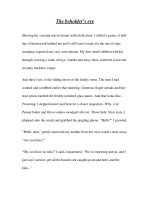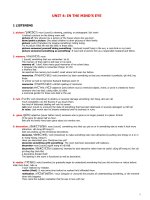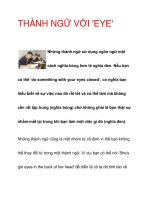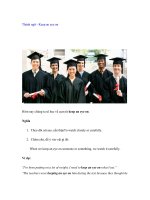eye wonder birds
Bạn đang xem bản rút gọn của tài liệu. Xem và tải ngay bản đầy đủ của tài liệu tại đây (11.23 MB, 48 trang )
Other titles in the series:
Big Cats • Bugs • Dinosaur
Ocean • Rain Forest
Reptiles • Space
Eye Wonder
Eye Wonder
Fly with amazing birds over deserts,
seas, woodlands, and lush rainforests.
•
From pink flamingos to chattering parrots and
racing roadrunners, there are lots of feathered
friends to meet.
•
Packed with facts, accessible text, and dramatic,
atmospheric photography, Eye Wonders are the
perfect educational start for young children.
•
Consultant Mark Fox is a senior lecturer at the Royal Veterinary
College and co-director of the Wild Animals’ Health
Course at London Zoo.
US
Open your eyes to a world of discovery
Eye Wonder
$9.95 USA
$14.95 Canadain Italy
Y C K
MT
Y C K
MT
3
Page
US
7/11/01
H74603
H03M00
Disk OP
NT1-2 K35
CT
00
SCAN
206/8
QC
KL00
Title: Eyewonder-Birds (Blad) DD010
Size: 261 x 412 mm (175# SG Elliptical)
Folio: (US Cover)
Title: Eyewonder-Birds (Blad) DD010
Size: 261 x 412 mm (175# SG Elliptical)
Folio: (US Cover)
see our complete product line at
www.dk.com
Printed in Italy
ISBN 0-7894-8550-8
Printed in Italy
Eye Wonder
4-5
What is a bird?
6-7
Songbirds
8
Woodworkers
10-11
Game birds
12-13
Birds of prey
14-15
Amazing owls
16-17
Watch-and-wait hunters
18-19
Camouflage
20-21
Colors of the rainbow
22-23
The parrot family
24-25
Wading in
26-27
Wonderful waterfowl
Contents
Written and edited by
Samantha Gray and Sarah Walker
Designed by Mary Sandberg,
Cathy Chesson, and Jacqueline Gooden
Managing editor Sue Leonard
Managing art editor Rachael Foster
US editors Margaret Parrish and Gary Werner
Jacket design Chris Drew
Picture researchers
Marie Osborn and Sarah Pownall
Production Kate Oliver
DTP designer Almudena Díaz
Consultant Mark Fox
First American Edition 2002
02 03 04 05 06 07 08 09 10 9 8 7 6 5 4 3 2
Published in the United States by
DK Publishing, Inc.
375 Hudson Street
New York, New York 10014
Copyright © 2002 Dorling Kindersley Limited
All rights reserved under International and Pan-American Copyright
Conventions. No part of this publication may be reproduced, stored in a retrieval
system, or transmitted in any form or by any means, electronic, mechanical,
photocopying, recording, or otherwise, without the prior written permission of
the copyright owner. Published in Great Britain by Dorling Kindersley Limited.
DK publishing offers special discounts for bulk purchases for sales promotions
or premiums. Specific, large-quantity needs can be met with special editions,
including personalized covers, excerpts of existing guides, and corporate
imprints. For more information, contact Special Markets Department, DK
Publishing Inc., 375 Hudson Street, New York, New York 10014
Fax: 212-689-5254.
A catalog record for this book is available from the Library of Congress
ISBN 0-7894-8550-8 ISBN 0-7894-8551-6 (ALB)
Color reproduction by Colourscan, Singapore
Printed and bound Italy by L.E.G.O.
See our complete product line at
www.dk.com
LONDON, NEW YORK, MUNICH,
MELBOURNE AND DELHI
28-29
Seabirds
30-31
Feathered but flightless
32-33
Meet the vultures
34-35
Opportunity seekers
36-37
Courtship
38-39
Nest building
40-41
Eggs and hatching
42-43
Caring for chicks
44-45
Globetrotters
46-47
Glossary and
bird habitats
48
Index and
acknowledgments
4
There are about 9,000 different species
of birds living on Earth, and all evolved
from reptiles millions of years ago. Birds
live in almost every part of the world,
from the icy Antarctic to
steamy tropical rain forests.
What is a bird?
Lightweight skeleton
This is a crow’s skeleton. As
with all flying birds, its bones are
hollow, like straws. Solid bones
would make
birds too
heavy to fly.
The ankle
bone.
This bird bone
has a honeycomb
structure.
The keel
anchors the
wing muscles.
Scaly toes
and feet.
Birds have wings
instead of arms.
Birds have a strong
horny beak and
no teeth.
Wishbone
Ulna, a
wing bone.
On the inside
Birds cannot chew food as they
do not have any teeth. Instead they
have a special grinding organ called
a gizzard, which is a part of the
stomach. Food is crushed as it
passes through the gizzard.
5
•
There are many millions
of birds living on Earth.
•
Only birds, bats, and insects
are capable of powered flight.
•
All birds have feathers,
even those that cannot fly.
Feathery facts
Fancy flier
As with all birds of prey, this red-tailed
hawk is a powerful flyer. The wings are
large and strong, allowing the hawk to
fly and soar for many hours at a time.
Wing shape and size varies hugely
between bird species.
Almost too small to see!
The tiny bee hummingbird
weighs only 0.05 oz (1.6 g), and
is smaller than some insects in its
rain forest home. The largest bird
in the world is the ostrich.
Useful feathers
Feathers are essential for flight,
but they also keep birds warm,
act as camouflage, and can be
used in mating displays. Each
bird has several different types
of feathers, including down,
body, and flight feathers.
The stunning
scarlet ibis is a
wading bird.
Different birds
The many thousands of
bird species are divided
into specific families.
The families include birds
of prey, songbirds, parrots,
waterfowl, and waders.
The chaffinch
is a perching
song bird.
The plumed
whistling-duck
is a waterfowl.
Down
feather
Flight feather
Body
feather
The nightingale’s special
voice box allows it to sing
its haunting song.
Some birds sing particularly
musical and enchanting songs.
They are called songbirds, and
the best known is the nightingale.
Songbirds have a special voice
box, called a syrinx, with thin
walls that vibrate as they sing.
In this way, they produce more
complex and beautiful sounds
than other birds.
Songbirds
Colorful chorus
The unusual song of male gouldian
finches is made up of hisses, clicks,
and long, shrill sounds. Living together
in flocks, rainbow-colored gouldian
finches are sociable birds.
Street singer
The warbling song of
European robins proclaims
their territory. After pairs
form to breed, only the
male sings. Under
streetlights, he may sing
into the night.
Star performer
The nightingale sings loudly and
musically. Its low, long notes
are particularly haunting.
Singing fearlessly through
the day and night,
the nightingale
is not a
shy bird.
6
7
•
During the breeding season,
male songbirds use their song
to entice females and warn
away other males.
•
The mockingbird can imitate
snatches of songs from 20 or
more other bird species, all
within a few minutes!
Feathery facts
Singing a love song
At dusk, the song thrush
finds a treetop perch and
delivers its powerful song.
Males looking for a
mate give the longest
performances. They
may also deliver a
battle song when
competing with
other males.
7
Tiny nutcracker
This nuthatch has a taste for
both insects and nuts. It cracks
open tough nuts by wedging
them into a hole on a tree
branch and striking
them with its beak.
It makes its nest
in a tree hole.
Many birds make their homes, and
base their lives, around woodlands
and forests. Nesting, feeding, and
socializing can all take place in a
tree. Different species of birds
prefer different trees.
Woodworkers
The drumming bird
There are many different kinds of
woodpecker, all living in heavily wooded
areas. Each bird pecks into a tree in
order to make a home, dig out insects,
and attract a mate.
Creeping around
Treecreepers are small
birds that spiral up and
around tree trunks in
search of insects.When
their journey on one
tree is complete, the
birds swoop down to
the bottom of another
tree and continue their
hunt for food.
Rooks’ nests sway
around in
high winds,
so they need
to be tough!
Life at the top
Rooks’ nests are likely to be built
high up in a tree. These large birds
tend to nest in the same tree, or
nearby trees, for life, and sometimes
even reuse old nests. Sociable birds,
rooks like to nest close together.
T
ONGUE TWISTER
Although it may be hard to
spot, woodpeckers have a
very long, sticky tongue!
This can be up to 4 inches
(10 cm) long and
is used to pull insects
out of trees. When not
in use, the tongue is
withdrawn back into
the bird’s head, out of
the way until the next
time it is needed.
W
o
o
d
p
e
c
k
e
r
s
a
r
e
a
b
l
e
t
o
d
r
u
m
o
n
a
t
r
e
e
s
e
v
e
r
a
l
t
h
o
u
s
a
n
d
t
i
m
e
s
a
d
a
y
.
8
Traditionally bred for sport, this
group of decorative birds includes
grouse, pheasants, partridges,
and quails. Game birds tend
to be ground-dwelling, and the
majority are not strong flyers.
Game birds
Spiked tail
feathers form the
shape of a fan.
Star turn
This male sage grouse
is staging a show to
impress the ladies!
Each spring, males
spread out their tails,
puff out their necks,
and utter deep
bubbling noises to
attract a female.
She then selects a
partner that she
likes the look of.
Troop of turkeys
Wild turkeys live in areas of the US,
favoring habitats that combine woodlands
and open clearings. They feed mainly on
plant material, although they may also
snack on insects and spiders.
10
Flock of pheasants
These large birds live in
pairs during the breeding
season and small flocks
throughout the rest of
the year. There are many
different species of
pheasants, so color and
markings varies widely.
11
12
Huge wings give ospreys
their ability to soar.
Fish-eating birds
of prey have bare
legs so that they
don’t get wet
“socks” during
a fishing trip!
Superb hunters, birds of prey have much
sharper eyesight than people. They catch prey
with their feet, swooping down to grasp their
victims. Their hooked beaks tear up the meal.
Birds of prey
American beauty
Bald eagles are the national bird of the US. They
snatch fish from just below the water’s surface.
Sometimes they plunge in after their prey.
They swim using their wings before
flying off with their catch. Their
heads are snowy white, not bald.
Pairs mate for life.
Fast fishing
Ospreys fly high over
water, diving down at high
speed to catch fish. Just before
hitting the water, they thrust their feet
forward and plunge into the water to
grab their prey. The osprey’s feet feel like
sandpaper, which makes them useful for
gripping slippery fish.
Snake snack
With the longest legs of any bird
of prey, the secretary bird attacks
from the ground rather than the air.
It uses its powerful legs to stun
a snake by stamping on it. The
secretary bird then kills the snake
by stabbing it with its back talon
before seizing it in its beak.
Tough scales on its legs protect
the secretary bird from poisonous
snakebites.
With its piercing
eyesight, the hawk
scans for prey over
a wide area.
High society
Harris’s hawks are unusually
sociable birds of prey. They
hunt in groups, working
together to catch prey that
has gone into cover. One
bird approaches to drive
it out and the others
hang back, ready
to chase the prey.
Invisible owl
In woodland, owls
slumber in trees
during the day.
Their brownish
feathers blend in with the
bark. This great horned owl has
tufts of feathers that look like horns.
Spectacular!
Spectacled owls
have markings that
look like a pair of
spectacles around
their eyes. The young
have the opposite
coloring of the parents
and are white with
black spectacles.
Most owls wake up as dusk falls.
They preen themselves, combing their
heads with their claws. Velvety flight
feathers muffle the flapping of their
wings as they take to the skies. Their
hoots, screeches, and whistles break
the silence of
the night.
Amazing owls
14
As white as snow
Sometimes called Arctic owls or ghost owls,
snowy owls change color with the seasons
from gray-brown to white. In the
snow, a white owl can sneak
up on prey unseen.
Turning heads
Owls have forward-
looking eyes. To see
to the side or back,
this barn owl must
turn its head. It can
swivel its head a long
way around.
Swift and silent
Sweeping silently
through the skies, eagle
owls listen intently for
small sounds. Their
prey may not even hear
them approach as they
swoop down to sink in
their talons.
Watch-and-wait hunters
Not all birds fly in search of food.
Many prefer to find a perch that
serves as a lookout post. There, they
watch and wait. As soon as they spy
their prey, they act fast to grab it. Some
snap up insects in the air, while others
swoop to seize them from the ground.
The kingfisher even dives
into rivers to catch fish.
Sitting and staring
The European roller’s lookout
perch can be anything from
a branch to a telephone wire.
From here, this colorful bird
watches for prey.
Dragonflies are a
delicious delicacy for
many watch-and-wait
hunters.
The flycatcher
eats many
different kinds
of insect.
16
The art of bee-eating
The bee-eater grabs insects in midair, even eating
bees and wasps! It grasps stinging insects in the tip
of its beak and rubs the sting against a perch or on
the ground. This squeezes out the venom or the sting
itself. The insect is then safe to swallow.
Making a splash
Perched on a branch over
a river or stream, kingfishers
watch for fish. When they spot
one, they dive after it at high speed.
Before hitting the water, they fold
their wings and close their eyes.
17
Camouflage
Hidden in all seasons
This white-tailed ptarmigan is a
master of disguise! As shown above,
in the cold winter months it is a
startling snowy-white. In summer its
feathers change to a rich brown
color. The main picture shows
the bird in the fall, with a
mixture of summer and
winter feathers.
To escape the attention of predators,
birds must be able to blend in with
their surroundings. Even brightly
colored birds such as parrots can be
hard to spot in exotic rain forests.
Other birds seem plainer, but their
disguises are just as good.
Life in the reeds
This hidden heron is an American bittern,
and lives in swamps and marshes in the US
and Canada. When threatened, the bittern
will freeze with its beak pointed upward,
sometimes gently swaying to blend in with
the surrounding reeds and grasses.
Safe on the beach
This ringed plover knows that her
eggs will be safe if they can’t be
spotted. A rocky section of beach is
the perfect place for this
wading bird to make
her nest.
These eggs look
just like the pebbles
that surround them.
19
Hot, steamy jungles that teem with life, rain forests provide
birds with a rich variety of food to feast on. Flowers
bloom and produce fruit where tall trees
reach the light, and the lower layers of
the forest swarm with insects.
Colors of the rainbow
Feathered friends
Brilliantly colored manakins hide
in the lush, leafy, lower branches of the
rain forest. Their fast flight and small
size makes them hard to spot, but there
are usually lots of them!
Shake your tail feathers!
On a rain forest perch, male birds
of paradise display their beautiful
feathers to attract mates. They raise
their tail feathers over their backs
and tip forward to show them off.
This scarlet-feathered
bird of paradise may
perform for hours.
20
Fast flapping
Jewel-like hummingbirds beat
their wings so fast that
they make a humming
sound. Hovering near
flowers, they sink in
their long beaks to
suck out nectar
and insects.
A
BIRD WITH A BIG BEAK
A toucan’s beak is up to one-third the
length of its body. It is so big that it seems
amazing that the bird does not
topple forward. In fact, the beak is
hollow and lightweight. It is also
useful. Toucans can pick fruit on
faraway branches. They toss the
fruit into the air and swallow it.
Toucan talk
With loud, croaking calls that
sound like a frog’s, toucans call
to each other as they fly in
search of fruit. Toucan pairs
play games of catch, tossing
berries to their mate.
Flowers produce a sweet
juice called nectar that
hummingbirds suck through
their strawlike beaks.
Containing more than 300 species, the
parrot family includes many of the world’s
most beautiful and brightly colored birds.
Some parrots live in dense tropical rain
forests, others in large open plains.
Flocks of pets
Sociable birds, budgerigars live in vast flocks
in Australia. Although small, budgerigars
can fly vast distances in hot and dry
weather in search of food and water.
Wild budgerigars are always green,
with a yellow face and black markings.
The parrot family
A muddy meal
These noisy macaws have gathered
on a mud bank in South America.
It is thought that they peck at the soil
and clay to get extra minerals that are
missing from their everyday diet.
•
Parrots are good climbers,
using their beaks and claws
to move around the branches.
•
Parrots eat mainly fruit,
nuts, and seeds.
•
If one parrot spots food, it
will alert the rest of the flock.
Feathery facts
Finger food
Many birds grip their food with
their feet, but parrots are the
only birds that can hold food
up to their beaks. Their fleshy
toes act like human fingers!
Rainbow colors
Parakeets are small parrots.
There are many species
of these birds, living in
flocks in warm and
tropical areas.
Loving parrots
Lovebirds live up to their name,
since they are fond of sitting in
pairs and preening
each other! All nine
species originally
come from Africa
and nearby islands.
The crested bird
Cockatoos are white,
pink, or black.Their large
head crests are raised
when the birds are angry,
excited, or frightened.
The fig is gripped
tightly in this green
parrot’s claws.
23
Wading in
Silent hunter
Gray herons are superb hunters
and often stand motionless in
the water for hours, waiting
for a fish to swim by. Their
razor-sharp beak is also
used to grab insects and
frogs, and occasionally
small mammals.
Flat-footed wader
There are eight species of jacana, a small tropical
wading bird with extremely large feet. The spidery
toes allow each bird to walk on floating plants. This
wattled jacana lives in Central and South America.
Wading birds live in swamps and marshes,
and along the edges of rivers and lakes.
These wet areas are an ideal home to
many birds, since the shallow water and
soaking land are full of food.
24
Flocks of flamingos
Flamingos always live in large flocks, and there may
be many thousands of birds in one group. Although
they are wading birds, flamingos are also
strong swimmers and flyers.
Feathery facts
•
Wading birds have long
legs so that their bodies don’t
get wet in the water.
•
Flamingos are pink
because some of the food
that they eat, such as
plankton and algae,
contains a special pigment.
•
There are five species of
flamingo in the world.
This flamingo is
filtering food with
its curved beak.
Filter feeding
Flamingos feed on tiny water creatures,
which they sieve out of the mud by filtering
them through their unusual, upside-down
beaks. These beaks contain rows of bristles,
called lamellae, which strain water.
25









